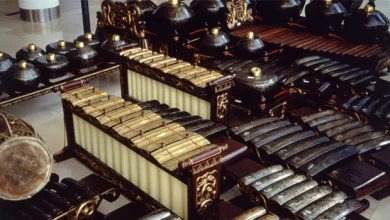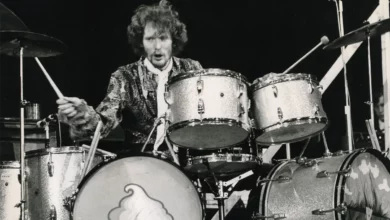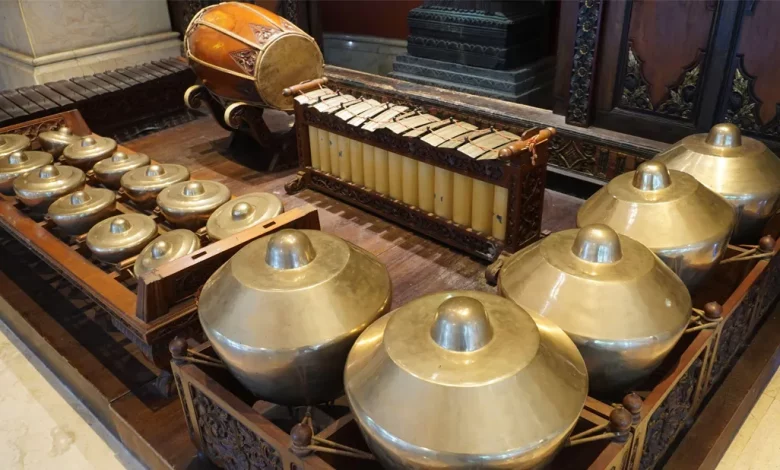
Gamelan is a type of percussion ensemble that originated in Indonesia. The ensembles are often considered orchestras because they contain not only a variety of idiophones, membranophones, and metallophones but also often include winds and strings.
I first learned about gamelan ensembles during my undergrad for instrumental music education. Music History III offered me many insights into this unique and historically decadent percussion group. I am excited to share what I’ve learned after going down many of what I like to call “gamelan rabbit holes.”
Where did Gamelan originate?
Gamelan originated in Indonesia. The word Gamelan comes from the Javanese “Gamel,” which means to hammer.
The origin of the Gamelan is shrouded in mystery, so it is hard to say which part of Indonesia can claim this type of music. The first written record of a gamelan ensemble goes back to the myth of Sang Hyang Guru, from around 230 CE Java. Guru was said to be a Hindu god.
The god supposedly needed a way to communicate with the other gods, who were very far away—so it is said that Gamelan was made. Gamelan has been influenced by both Hinduism and Buddhism over time.
What does Gamelan sound like?
If you are only accustomed to listening to Western-style music, Gamelan may sound dissonant and jarring to you at first. However, my tastes have changed as I’ve listened to more world music. Gamelan ensembles sound metallic and complex, with interweaving parts and a mosaic of rhythms.
Types of Gamelan Ensembles
Gamelan ensembles can be divided into two main categories: Javanese and Balinese. While there are other types of Gamelan, these two are the most well-known.
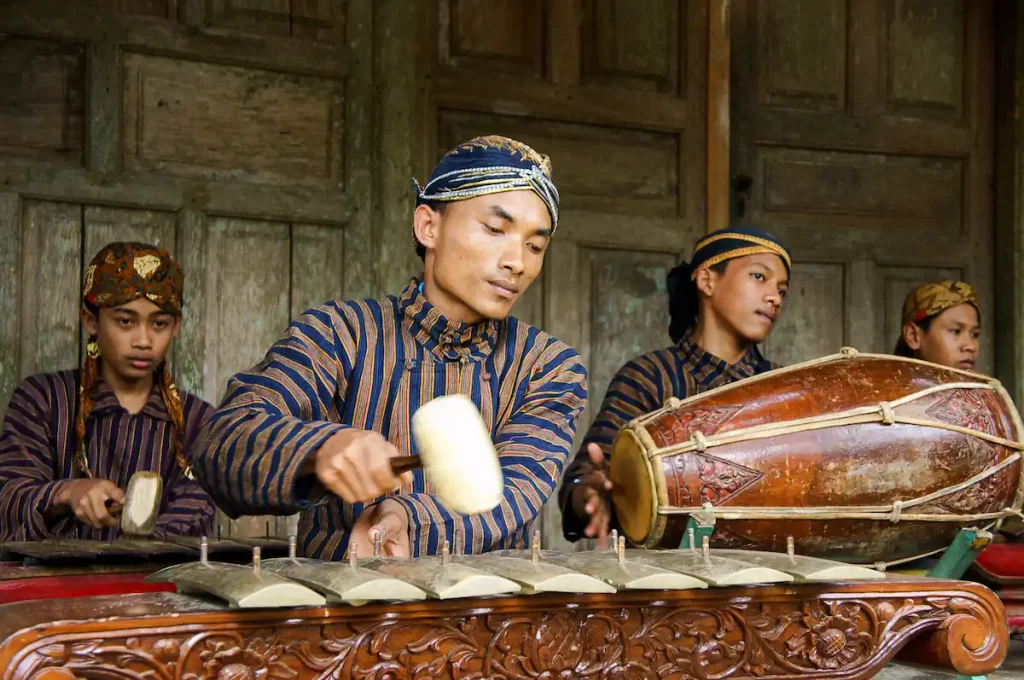
Javanese gamelan ensembles are (fittingly) from Java, and Balinese-style Gamelan are from Bali. Each region uses different modes, and there is some variation in instrumentation and mallet styles.
Balinese Gamelan tends to sound more energetic and bright, whereas Javanese Gamelan feels tranquil and soft. Moreover, while the Javanese and Balinese gamelan use a similar set of instruments, the style they play them is vastly different.
Side note: Another type of Gamelan you may have heard of is Sudanese. Sudanese Gamelan originated in West Java and uses a unique mode of the degung scale. You can also hear instruments with resonators, unique to this subset of Javanese Gamelan.
What types of instruments make up a gamelan ensemble?
Percussive instruments that make a gamelan ensemble include: xylophones and metallophones, gongs, and drums (membranophones). However, most instruments in Gamelan are struck idiophones, meaning that the sound is created from vibrating on its own.
Gamelan can have up to 50 or 60 different types of instruments. Here are some of the standard instruments that you might find:
- Kendhang
- Bonang
- Gambang
- Saron
- Gong

Kendhang is a membranophone (drum) with a drum head on either side. The heads are usually made with goatskin leather. You will most often hear this drum during quick sections.
The role of playing kendhang is quite significant, as the instrumentalist helps set the tempo and feel of each section. Kendhang players also help lead the group when accompanying shadow puppetry (Wayang). You will typically see at least two or three sizes of kendhang in each ensemble.
A bonang is a kettle-type gong that you will see in sets, supported by a wood frame. One interesting fact about bonag is that the wood frame is often made from the lumber of the jackfruit tree.
The bonag kettles/ pots themselves are made of bronze. This instrument can be found in Javanese gamelan ensembles. Bonag-type instruments in Balinese Gamelan are called reong.
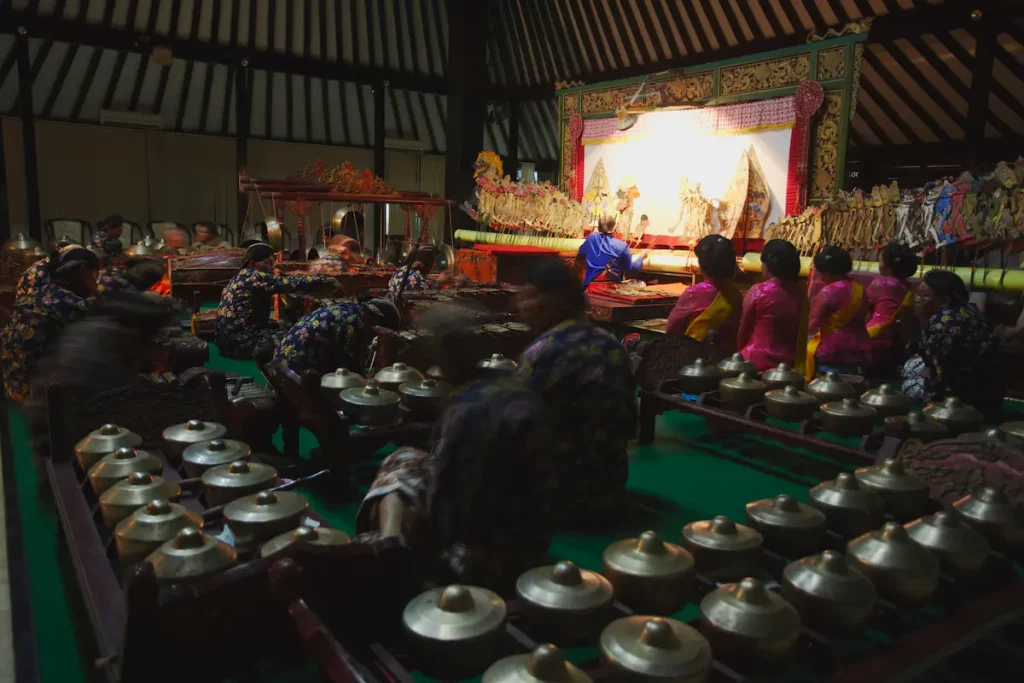
There are several different types of bonag. The sets of kettles are named by pitch and usually come in a group of 12-40. There is a small and high-pitched bonag (bonag panerus), a mid-range bonag (bonag barung) and a low bonag (bonag panembung). The instrument sounds like a gong.
Gambang are pitched instruments with wooden bars that look similar to a xylophone. Many people confuse this instrument with the saron, another barred instrument.
However, the saron is usually much smaller, and the bars are made of metal. Another significant difference is how the instruments are used. Saron play simpler and shorter lines when compared to the complex melodies of the gambang.
The gong, or gong ageng, is one of the most vital instruments in the ensemble. This gong signifies the landmarks in the music; the beginning, when to transition to another cycle, and when it is the end of the piece. The gong ageng is a metallic idiophone, and almost looks like metal cooking pots on a wooden bench.
Other Instruments In Gamelan
Non-percussion instruments in Gamelan include:
- Rebab
- Chorus
- Suling
Many call a gamelan ensemble a ‘gamelan orchestra’ because the group often includes reeds vocals, zithers, violin-like instruments, and flutes (suling). Gamelan is also known as a “Sekaha.”
A rebab is a violin-shaped instrument with two strings instead of four. One fascinating thing about the rebab is that it does not have a fingerboard! Bowed strings are thought to be a newer addition to the Gamelan ensemble.
Chorus sometimes accompanies Javanese Gamelan. The group performs in unison. Vocalists in Gamelan are also referred to as gerong. The words are usually sacred Javanese poetry, or macapat.
A suling is a type of bamboo flute and can be either transverse or vertical. These four to six-hole wind instruments provide sound effects like slurs to a tremolo-like sound.
Gamelan Culture
Gamelan players often bow before performing to show their respect. This is common in Hindu and Buddhist cultures and represents bowing to the divineness within the other person.
Unlike here in the west, the instruments that make up this unique percussion ensemble belong to no one. On the contrary, they believe music and instruments belong to everyone.
The Gamelan is traditionally housed in a building with thin walls. All instruments are treated with the utmost respect and are always to be stepped around (not over) for fear of offending the spirits.
What scales are used in Gamelan?
Gamelan music is modal, meaning they use scales outside the realm of major and minor. (Central) Javanese Gamelan often uses the following scales: slendro and pélog.
Slendro is a pentatonic tuning made up of 5 notes. It almost sounds like a Western-style whole-tone scale. The slendro way of tuning is considered older than pélog. Pélog is a 7-note scale/tuning, with nearly a half-step at the top of the scale.
Other modes that you hear about include degung and madenda.
Remember that while Gamelan scales can be likened to Western scales and notation, they use an entirely different system. We don’t usually use quarter tones here in the US (unless you are Jacob Collier!) So it’s hard to compare tomatoes with apples, even if they are both fruits. This brings me to the next point: notation.
Is the Music Notated or Played by Rote?
Balinese gamelan players all play by rote, and Gamelan music began by rote—that is, it is not traditionally recorded on paper.
That being said, you can find some sheet music today. If gamelan music is notated, it is typically done in charts or numbers rather than Western-style sheet music. Unfortunately, there is no one way to record gamelan music, as many players have made their own individual notation system.
Javanese musicians use numbers if music is notated, whereas the older school of notation uses names derived from body parts (note #1 is the word for head, note #2 is the word for neck, and so on).
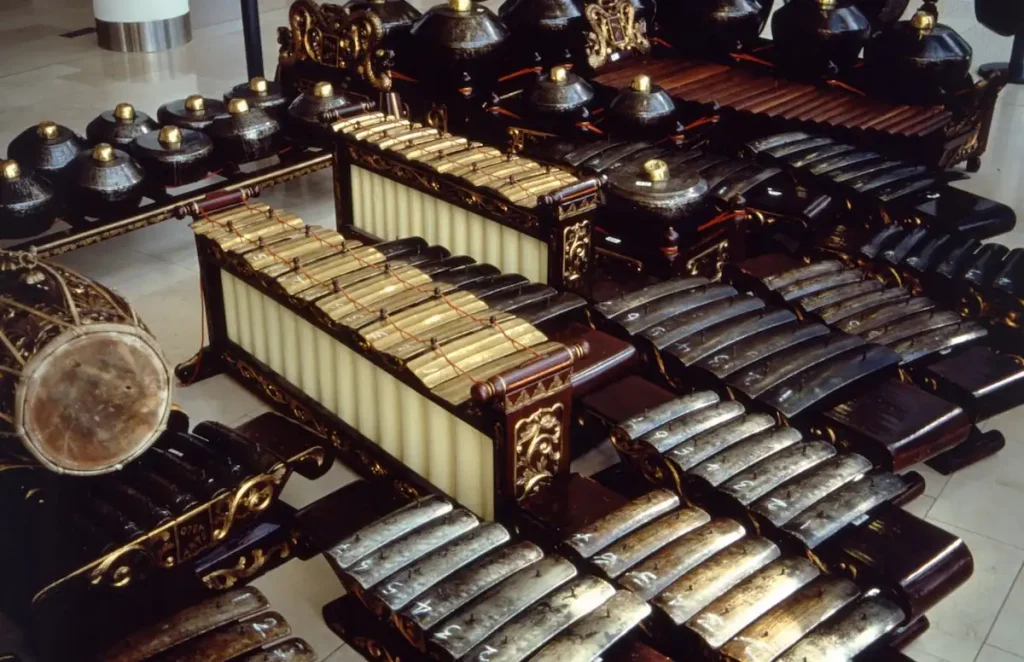
Where is Gamelan Used?
Gamelan ensembles often accompany Wayang, which is a type of theatre. But Wayang is different from the theatre you are imagining. First, it involves puppets and shadows rather than actors. Second, Wayang tells tales of the gods of old.
Gamelan can also be heard on the radio, and ensembles perform for special occasions such as dancing and ceremonies.
Gamelan in Western Culture
Claude Debussy was one of the many European musicians taken by Gamelan. He first heard Gamelan when he was at a fair and saw an exposition in Paris. There are entire books dedicated to Debussy’s music after exposure to Gamelan, such as “Echoes from the East“ by Kiyoshi Tamagawa.
Other musicians inspired by the ensemble include ethnomusicologist Bela Bartok and minimalist composer Philip Glass. You’ve probably heard Gamelan in some movies you’ve seen, like the first Avatar and The Hobbit. While it may seem unlikely, there are dozens of gamelan ensembles in the US alone.
Kulintang
As Gamelan spread, it changed. One ensemble that is the result of Gamelan is kulintang from the Philippines. Kulintang’s origins are still considered ancient. The group shares several instruments with Gamelan, including the metallic gongs. Kulintang had a significant resurgence in the 1950s through the 1970s when Western people began using it for spiritual purposes, combining it with their instruments and fusing it into Western genres.
Conclusion
Gamelan ensembles have indeed spread far and wide since 230 CE. So if you ever get the opportunity to see this unique and sonically rich group, take it!
